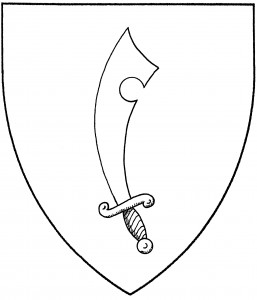The term “seax”, when used in blazon, denotes a stylized sword resembling the scimitar but with a semi-circular notch in its back. It was attributed c.1460 to the arms of the Kings of Kent [RH]; it has more recently been used in the arms of Middlesex and Essex, presumably for the cant.
Many large knives of the Early Middle Ages, especially in England, have been termed “seaxes” by weapons historians; these do not resemble the stylized heraldic form. In Society armory, such cases are explicitly blazoned by type, e.g., the pre-Conquest “broken-back seax”, based on an item unearthed at Sittingbourne (currently in the British Museum).
Theodric Pendar of Faulconwood bears: Sable, upon a saltire cotised Or two seaxes in saltire sable.
Phillip of Dalarna bears: Vert, a seax between two estoiles wavy argent.
Eadgyth æt Stæningum bears as a badge: On a broken-back seax argent a flax stem vert flowered azure.
